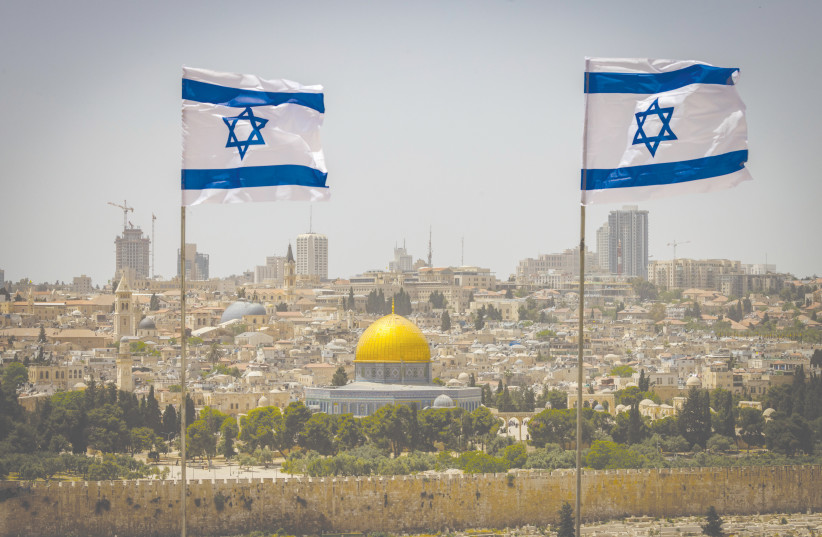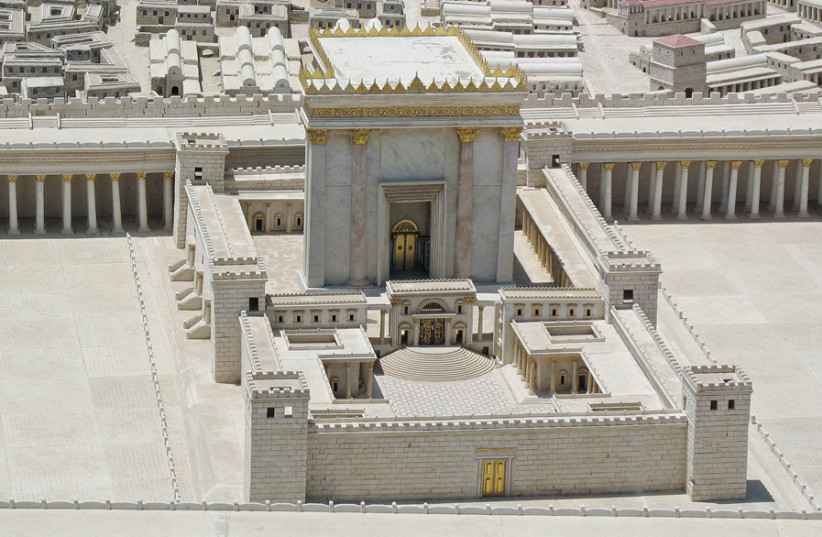by Douglas Altabef
Hat tip: Dr. Jean-Charles Bensoussan
What ensued has been one of the greatest failures and embarrassments of the state of Israel: the willing severance of the connection of the Jewish people from its holiest site.
 |
ISRAELI FLAGS flap in the wind on the Mount of Olives, overlooking the Dome of the Rock and Temple Mount.
(photo credit: OLIVER FITOUSSI/FLASH90)
|
For centuries, indeed millennia, our ancestors have reaffirmed the centrality of Jerusalem to their understanding of what it means to be both in a covenantal relationship with God and to be part of the Jewish People.
It says in Psalm 137:5, “If I forget thee O Jerusalem, let my right hand forget its skill.” It is said at our happiest moments and is an affirmation intended to make sure that all joy must be tempered with the awareness that, while we privately rejoice, the source of our greatest rejoicing, both public and private, has been taken from us.
“If I forget thee O Jerusalem, let my right hand forget its skill.”
Psalms 137:5
When we promise not to forget Jerusalem, what is it that we conjure up in our minds and hearts? What is it that we associationally capture in order to never forget Jerusalem?
While we might have idealized visions of what the place might have looked like, we also have extensive descriptions of how the heart of the city appeared. That heart, that crown, was the Temple, of course. It was resplendent, magnificent and beckoning, yet also aloof.
If, as we learn, the nations of the world flocked to Jerusalem, it was not to visit the existing rendition of the Mahaneh Yehuda shuk (outdoor market). It was to be awestruck and moved by the presence of God’s abode on Earth: The Temple.

The Temple was the epitome of the magnificence of Jerusalem and Jerusalem as a place was indistinguishable from the Temple that crowned it. Today, we have been blessed to once again be part of the life of the city that we have sworn eternal association with. We can marvel at its old walls and we can explore, with head-shaking wonder, the newly unearthed tunnels and passages that link us to Davidic times.
But, alas, that which made Jerusalem the great city is no more, and even worse, we are hard-pressed to even visit the site of its crown. Today, those who respectfully wish to visit the Temple Mount, the enormous Herodian creation on which the Temple was built, will undergo a process of humiliation and debasement for their loyalty.
Ironically, while we triumphed miraculously some 55 years ago against an array of genocidal enemies and recaptured the Old City of Jerusalem, we almost immediately surrendered our greatest prize: the unfettered control of the Temple Mount. What ensued has been one of the greatest failures and embarrassments of the state of Israel: the willing severance of the connection of the Jewish people from its holiest site.
INSTEAD OF our maintaining control of the site and thereby guaranteeing equal and fair access to all those who would visit and pray there, consistent with the dictates of their faiths, Israel handed control and functional sovereignty over the mount to the Jordanians, the same people who systematically destroyed all vestiges of Jewish worship in the Old City of Jerusalem during their hateful control of the area from 1948 until 1967.
True to form, the Jordanian Wakf created dhimmi-like (second class citizen) rules and protocols for Jews that the rest of the world was quick to enshrine as a status quo. No Jewish prayer, no prayer books nor articles of worship. Humiliating entry procedures, made all the more galling because they have been administered by Israeli police, featuring only one entry gate, accessed by the most rickety pedestrian bridge in all of Israel, and only for very limited times during certain days.
It is nothing short of surreal to have experienced an uplifting and ennobling encounter with the Kotel, the Western Wall (of the Temple Mount compound), only to be brought down to earth and then some, by trying to ascend to the mount. That’s the bad news.
Here’s the compensating silver lining.
It is the Jewish people who are leading the way back to the Temple Mount. It is because of our resolve, our true remembering to never forget the essence of Jerusalem that, slowly but surely the connection between us and our sacred home is being re-established.
Thanks to dedicated organizations and intrepid individuals willing to challenge absurd and bizarre protocols by being arrested and charged with heinous crimes such as uttering the Shema prayer, we are delivering a clarion call to return. Ironically, the very humiliation of the current regime has not only made a visit to the Temple Mount that much more unforgettable, but also has strengthened the resolve of Jews, religious and secular, to not only remember, but also to return. And to return in dignity.
Jerusalem cannot be said to be truly re-unified until the connection between the Jewish people and the Temple Mount is made manifest and seamless. Only when the Temple Mount is truly b’yadenu (in our hands) will we be able to say that not only have we never forgotten Jerusalem; not only have we kept true to it, but most importantly, we will have done our part to restore the Jerusalem that has been at the center of our faith and our peoplehood for 3,000 years.
Douglas Altabef is a director of B’yadenu, which advocates for Jewish rights on the Temple Mount. He is also chairman of the board of Im Tirtzu and a director of the Israel Independence Fund. He can be reached at dougaltabef@gmail.com
Source: https://www.jpost.com/opinion/article-708108
No comments:
Post a Comment